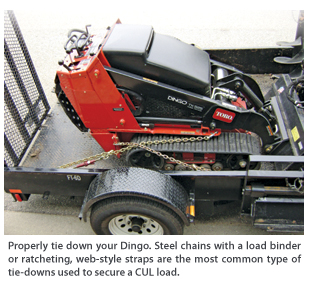Charge of the Light Brigade
 Compact utility loaders are small and nimble machines, but they’re still heavy enough to do damage. Operation requires safety precautions and so does hauling on the road. Because a compact utility loader (CUL) is probably the heaviest piece of equipment on the trailer, its placement plays a major role in how the trailer tracks during transport. It’s important to properly place and secure all equipment to a trailer to prevent equipment loss and load shifting that could make the trailer or tow vehicle uncontrollable.
Compact utility loaders are small and nimble machines, but they’re still heavy enough to do damage. Operation requires safety precautions and so does hauling on the road. Because a compact utility loader (CUL) is probably the heaviest piece of equipment on the trailer, its placement plays a major role in how the trailer tracks during transport. It’s important to properly place and secure all equipment to a trailer to prevent equipment loss and load shifting that could make the trailer or tow vehicle uncontrollable.
Weight Placement
The majority of the weight should be centered or slightly forward of the trailer axle for the trailer to track straight behind the tow vehicle.
Trailer Types
Trailers can have side rails or trays for specific attachments or openings on the outside of the trailer for attachments that can be secured with a hitch pin. D-rings placed on the bed of the trailer or the side rails may be used to secure equipment using a strap or chain.
Strap and Chain Standards
Securing the load by using the proper strap or chain is important for safety on the road. Steel chains with a load binder or ratcheting, web-style straps are the most common type of tie-downs used to secure a load. Many states require chains for security of equipment. Although chains are more expensive, they last longer, don’t fray and in some cases are easier to use.
Securing the CUL
For example, the Toro TX and wheeled Toro Dingo loaders have frame openings for a hook to secure the unit to the trailer. The front of the TX has a 1-in. opening on the left and right side of the frame for the hook end of the chain or strap. The 2-in. by 4-in. metal loops welded to the rear of the frame behind each of the tracks can be used to secure the chain and strap, too. For Toro units, the straps or chains should pull forward and backward to assure the load does not shift in either direction during braking or acceleration.

Comments are closed here.